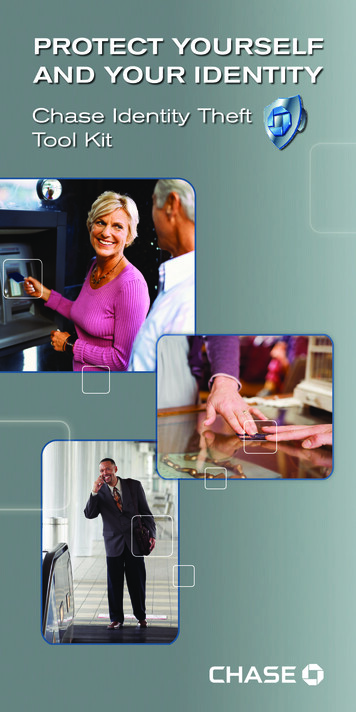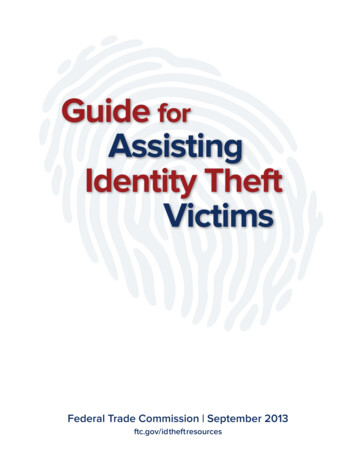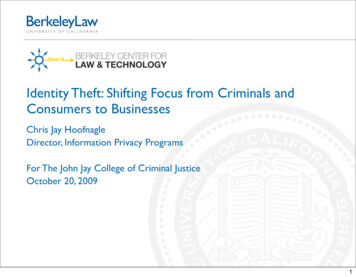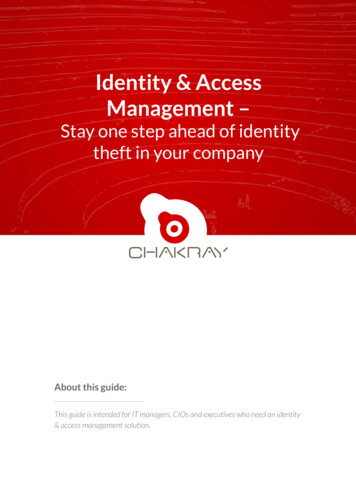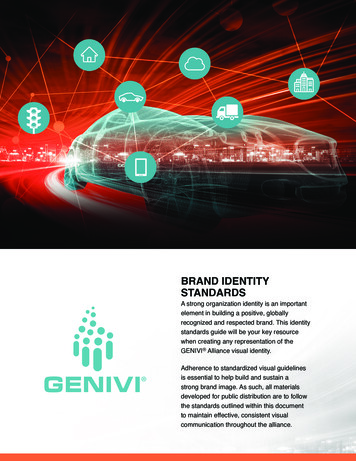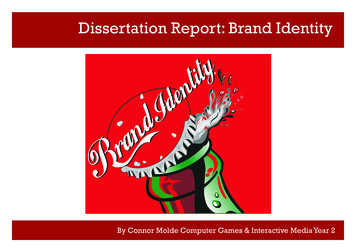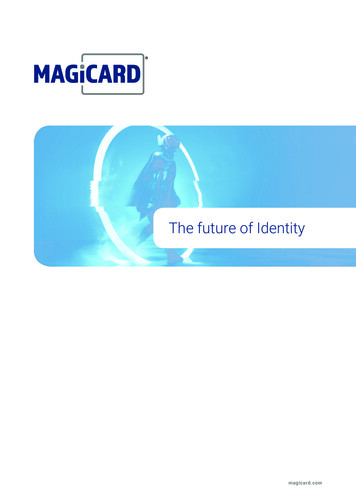
Transcription
The future of Identitymagicard.com
Table of ContentsIntroduction.3The increasing trend of identity theft.4What makes identity data susceptible to breach?.5Single ID solutions are not enough.6Single trusted login vs de-centralising information.8Growing costs of regulation.8Conclusion.9THE FUTURE OF IDENTITY2
IntroductionBefore we take a deep dive into the future of identity, it would be prudentto understand what constitutes an individual’s identity. The most visibleaspect of a person’s identity is his/her photograph or facial recognition.After all ‘putting a face to a name’ does help put things in perspective formost, often setting the right tone and expectations of your interactionsith the individual. However, identity is made up of many other aspectsapart from a photograph. It includes: FingerprintsIris recognitionEar printsGenderTeethVoiceAnd these are just the physical form factors. If you add context, location,style of dress, signature, identity becomes a complex sum of attributes ofan individual. The TechVision Research Group says that identity is one ofthe most fundamental building blocks for any level of communication,collaboration or commerce within and across an organisation but that italso brings with it a fair share of fundamental challenges includingprotecting individuals’ privacy and the theft of identity data. Over thelast few years many organisations have seen firsthand how these twochallenges can steamroll them, resulting in identity data becoming moreof a liability than an asset.THE FUTURE OF IDENTITY3
The increasing trend ofidentity theftOut of all the kinds of breaches that occur – identity information loss,financial account loss, account access loss and existential data loss identity information loss tops the list.Data breach by type frequency scoresIdentity information lossFinancial account lossAccount access lossExistential data loss2.521.510.520132014201520162017Frequency scores are calculated as the ratio of frequency of a type of loss and the sumof frequencies for other types of data loss1.Identity information includes but is not limited to names, dates of birth,addresses and account passwords of consumers. In the last five years bigcorporates such as Yahoo, eBay, JP Morgan Chase have fallen victim tohefty losses as a result of identity theft.According to consumer credit reporting company, Experian, identity dataranging from subscription services, credit card data and passports canfetch anywhere between a 1 to 2000 when resold or misappropriated,clearly explaining the increasing trend of identity theft – a staggering 10billion identities since 2013.The healthcare industry that by far has the most number of breachescompared to any other industry also has an alarming story to tell.Prescription fraud in England – when people who are not entitled to freeprescriptions assume fake identities and abuse the healthcare system –costs the National Health Services (NHS) 256m a year.1The Conversation Data Breach Live IndexTHE FUTURE OF IDENTITY4
What makes identity datasusceptible to breach?When it comes to managing identity data, organisations need to determineand enforce appropriate access to enterprise systems and applications andthis comprises two primary components: authentication and authorisation.While authentication looks at identifying who you are via a host of enablerssuch as passwords, PINS, digital certificates, one-time password tokens,etc, authorisation looks at providing access to you basis your entitlementand/or affiliation once the identity has been determined.The issue of course is the grey area of these enablers – they are imperativein today’s world because self-assertion of identity simply won’t suffice, butat the same time most of these enablers can easily be compromised.Shoulder surfing - the practice of looking over the shoulder of a user at anATM or a secured access facility in order to obtain their personal identification number, password, etc is quite common. Similarly trojan software thatprompts users to download fake applications can create havoc by relegating control of your device to the hacker who then proceeds to interceptmessages containing OTPs etc.THE FUTURE OF IDENTITY5
The way forward: single IDsolutions are NOT enoughIn a world that is rapidly changing thanks to the sweeping waves of a digitaltransformation, a single ID solution is just not robust enough to handlethe rigours of a foolproof identity and access management (IAM) system.Combining security layers or components to create a ‘true identity’ is theway forward.Some of the options that have gained popularity include the usage ofbiometrics – fingerprints and retina scans, using a mobile phone orwearable device for easy and quick identification and even small RFIDimplants under the skin that grant immediate access to facilities. If thelatter option seems out of a science fiction thriller, this couldn’t be fartherfrom the truth. Thousands of people in Sweden have more than justdabbled with this idea and injected microchips in their hands as far backas 2015. For many it’s opened a new way of life, where the microchipreplaces membership cards to gyms, provides a hassle free option ofbooking a train ticket, replaces the need to carry keys, etc2.But perhaps one of the most popular and convenient means ofidentification is fingerprint biometric authentication. It is used widelyacross organisations as a means for employees to log in and log out forthe day, gain access to certain facilities etc. Fingerprints are a surefiremethod of authenticating an individual’s identify because unlike PINS andPasswords, they cannot be stolen, lost or forgotten. In an emergencysituation such as in a healthcare setup, fingerprint biometric authenticationcan be the difference between life and death. When the prints are storedon a smart ID card, it can limit treatment areas in the hospitals to onlylegitimate staff, thereby protecting patients. Patient biometric cards thatare linked to crucial medical records such as blood type, drug sensitivitiesand allergies have huge potential in saving lives, especially when patientsarrive unconscious and accurate authentication is p-implants-new-way-lifeTHE FUTURE OF IDENTITY6
Single trusted login vs de-centralisinginformation - the debate is onGovernments world over are the custodians of their citizens data and they are in fact themost vulnerable to identity data breaches. While India’s unique identity card database(aadhar) has received its fair share of criticism for not being secure enough, the UKgovernment’s identity assurance system – GOV.UK Verify that is intended to provide a singletrusted login across all UK government digital services is facing a number of teething issues.A report from the National Audit Office claims that the UK government’s flagship identificationscheme has fallen way short of its target of registering 25 million users by 2020 and has onlybeen able to notch up 3.6 million users so far3.A technology that is rapidly gaining ground as a potential option to safeguard personal datarecords is blockchain. Often misunderstood and related simply to what it has achieved in thespace of Bitcoin and other crypto currencies, blockchain is a next generation database thatdecentralises information rather than maintaining it in one central location. This feature ofblockchain is what makes it so attractive to collect, move and secure data. A common analogyis to compare the ease of robbing a house versus robbing an entire city. Blockchain will allowinformation to be stored across the entire city with control firmly in the hands of the individualwho has the cryptographic private keys needed to access the dispersed information.Of course it is still early days for utilising blockchain as an efficient means of managingpersonal data records, but the idea of encrypting data holds immense value and can beimplemented swiftly. Unfortunately enough, companies till now have been found wantingin this area. Digital security company Gemalto says that of the whopping 9.2 billion stolenrecords that have been recorded since 2013, only a meagre 368m were concealed frompotential hackers through the use of data-encoding 444308 Verify: Inquiry criticises government ID schemeTHE FUTURE OF IDENTITY7
Growing costs of regulation and whycompanies need to rethink how theysafeguard dataOne of the most defining pieces of legislation that has come out in the recent past is the EU’s General DataProtection Regulation (GDPR) that seeks to enhance consumers’ privacy protection, holding the companies whostore the personal data records accountable and punishable by law for frauds committed if any. According to asurvey conducted by global law firm, Paul Hastings LLP, the costs for a Fortune 500 company to comply with thestrict guidelines of GDPR could run into 1 million just for technology alone. Of course the costs of noncompliance with GDPR are even more prohibitive, amounting to fines of 20m or 4% of a firm’s global annualsales figure – whichever is greater.Ponemon Institute and Globalscape also recently conducted The True Cost of Compliance with Data ProtectionRegulations to determine the full economic impact of compliance activities for a representative sample of 53multinational organisations.The study showed that while the average cost of compliance for organisations was currently US 5.47 milliondollars, a 43 percent increase from 2011 when the study was first done, the cost of non-compliance waseven higher.US millions 16.00 14.82 14.00 12.00 10.00 9.37 8.00 6.00 5.47 4.00 3.53 2.00 0.00FY2017sCompliance CostNon-compliance CostFY2011Ponemon: Difference between compliance and non-compliance costTHE FUTURE OF IDENTITY8
ConclusionWhichever way you look at it, companies can ill afford to do nothing whenit comes to securing identity data. In fact it would be astute to say thatidentity and security go hand in hand - you can’t think of securingsomething without knowing who is entering the system and what theirrights are. Similarly you can’t establish identity if the system is insecurein the first place.With Identity management systems rapidly scaling over the next five yearsin response to trends such as an all-pervasive Internet of Things (IoT)ecosystem, everything moving to the cloud and increased proliferationof wireless and mobile /BYOD, organisations must act now before it istoo late.In the meantime, a step in the right direction today is the ability to captureinformation in a usable form. By that we mean personal information that’snot simply a 2D photo ID badge as that is only useful if the personreviewing the ID is known to the badge holder. Multifunction chips whichcan identify an individual in the context of location, biometrics and otherphysical attributes in conjunction with other technology such as mobilephones are the way ahead.THE FUTURE OF IDENTITY9
corporates such as Yahoo, eBay, JP Morgan Chase have fallen victim to hefty losses as a result of identity theft. According to consumer credit reporting company, Experian, identity data ranging from subscription services, credit card data and passports can fetch anywhere between a 1 to 2000 when resold or misappropriated, clearly explaining the increasing trend of identity theft – a .


